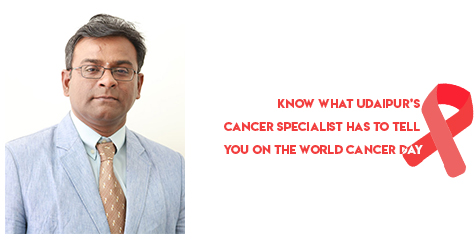On the occasion of World Cancer Day, February 4, this year, it is perhaps worthwhile to know about the condition of the dreaded disease in the city, the main causes, symptoms, remedies etc.
Facts and Figures about Cancer
The recent figures about the disease are quite alarming, while over 26% of all deaths in India are from heart diseases, 7% are from cancer. Cancer, diabetes, and hypertension account for 35% of all deaths in India. Over 10 Lac new cases of cancer are diagnosed every year in India. Cancer cases in India are likely to increase from around 14 lacs in 2016 to over 17.3 lac by 2020. Deaths due to cancer are projected to go up from 7.36 lac annually to over 8.8 lac by 2020.
According to a recent survey in Rajasthan, there are about 2.5 lac cancer patients in the state and to it every year about 40,000 new patients are dead. It is possible to save about 60% of the patients if treatment starts at an early stage. According to specialists Rajeev Gandhi, Cancer Research Centre New Delhi, the growth of cancer was about 36% twenty years ago but now it has gone up to 65%. Due to the supporting system of chemotherapy, the side effects have gone down. With the new technique, the hospitalization period has become shorter and the tolerance of the medicine has also gone up.
According to Dr. Narendra Rathore, HOD, Cancer Dept., Govt. M.B Hospital, Udaipur, 10 lac people out of about 1.25 lac become victims of cancer and there are 24,000 cancer patients in Udaipur. The figures of cancer patients in Govt. M.B Hospital Udaipur are in the year 2005 (3000 outdoor and 1300 indoor), 2010 (4200 outdoor and 1450 indoor), 2014 (5300 outdoor and 3800 indoor) and up to December 2016 (10,200 outdoor and 8200 indoor). According to Dr. Rathore, cancer of mouth, tongue, uterus, breast, large intestine, liver, prostate, and blood fall into the category of main cancer. In men, the main cancer is in mouth, lungs, and stomach. Thirty percent of cancer is of mouth and neck. Among women the cancer of breast, cervical and large intestine is common out of total cancer patients 28% have cervical cancer.
Last year in Govt. M.B Hospital, Udaipur 30 to 50 cancer patients came in the outdoor radiotherapy dept. daily and there were 30-40 indoor patients. Everyday radiotherapy was given to 60-70 patients in two shifts from 9 am to 7 pm. The patients came from far off places such as tribal areas, Chittorgarh, Bhilwara, Neemach, Mandsaur, and Jawra. Last year a new cobalt therapy machine costing 4 crores was installed with the help of which radiation therapy was given in 1.5 to 2 minutes whereas the old machine took 5-6 minutes.

According to former Dr. Shankar, Director, Radiation Oncology, Geetanjali Medical College Hospital, Udaipur, cancer is the general name for a group of more than 100 diseases. Although there are many kinds of cancer, all cancers start because abnormal cells grow out of control. Untreated cancer can cause serious illness and death.
What is a Tumour?
A tumor is an abnormal lump or collection of cells, but all tumors are not cancer. Tumours that are not cancer are called benign. Benign tumors can cause problems. They can grow very large and press on healthy organs and tissues. But they can’t grow into (invade) other tissues. So, they also can’t spread to other parts of the body. These tumors are seldom life-threatening.
Signs of Cancer
Talking about early signs of cancer, Dr. Shankar says that they could be new lumps or growths on the skin. A sore or bruise that does not heal, a mole that changes in shape, size or colour or bleeds in unusual circumstances, an ongoing cough or hoarseness that last longer than three weeks, indigestion and difficulty in swallowing, a change in bowel or bladder habits for no good reasons, shortness of breath, loss of appetite, unexplained weight loss or tiredness and blood anywhere it normally should not be- in urine, bowel motions or from spitting.
What can cause cancer?
In 75% cancer cases, there are modifiable factors such as smoking, obesity, diet, sedentary lifestyle, alcohol, and air or water pollution and in 15% cases, it is due to modifiable factors like infections, ionizing radiation, hormones, occupational factors. Non-modifiable factors like age, sex, race and genetic become the cause the remaining 10% cases. Smoking a main cause of cancer causes 14 types of cancer. The most damaging components of tobacco smoke are tar, carbon monoxide, hydrogen cyanide, oxidizing chemicals, dangerous metals and radioactive compounds. Obesity is another cause of cancer and for safety, one has to do physical activity and set behavioral and diet goals.
The main cancer fighting, foods are strawberries and blackberries, leafy vegetables, garlic, grapes, tomatoes, apple, broccoli, cabbage, tea, and coffee.
Ultraviolet rays from are welding torches and mercury lamps can also cause cancer. Some particles are known as primary particles that are emitted directly from a source such as construction sites, unpaved roads, fields, and fires can also cause cancer. Secondary particles that are formed in complicated reactions in the atmosphere of chemicals such as sulphur-dioxides and nitrogen oxides that are emitted from power plants industries and automobiles can be sources of cancer. Indoor pollution through biological pollutants like molds, bacteria, viruses, and pollen can also cause cancer. Second-hand tobacco smoke when some other is smoking is also dangerous.
Also dangerous are combustion pollutants that come from sources such as fuel burning stoves, furnaces, fireplaces, heaters and water heaters using gas, coal, oil, wood or other fuels Radon, a naturally occurring radioactive gas that can enter the homo through cracks in the foundation, floor and walls, drains and other openings is also harmful. So also, asbestos that is present in many products found in the home including roofing’s, floorings etc. Formaldehyde, found primarily in adhesive and bonding materials is also harmful. Cell phones emit radiofrequency energy (radio waves), a form of non-ionizing radiation.
Tissues nearest to where the phone used a cell phone for 50 minutes, brain tissues on the same side of the head as the phone’s antenna mobilized more glucose than did tissues on the opposite side of the brain. The researchers note that the results were preliminary and possible health outcomes from this increased glucose metabolism were still unknown. Individuals who are concerned about radio frequency exposure can limit their exposure, including using an earpiece and limiting cell phone use, particularly among children.
Concerned about the suffering of cancer patients the Union Govt. is set to roll out a massive door to door screening programme for the early detection of cancer heart disorders and diabetes which account for over 35% of deaths in India. Under the initiative, the Govt. aims at testing over one-third of the population comprising zoo districts across the country in one year. The program is among the preventive- care measures planned by the health ministry and is targeted at people in the age group of 30-69 years, who constitute almost 37% of the total population. This population is highly vulnerable to non-communicable diseases that are responsible for 55% of the premature mortality in the same age group.
Nearer home, realizing the importance of education as an important component of cancer control programmes, Dr. V. Shankar has initiated Cancer Olympiad in Udaipur. It comprises a series of planned activities aimed at educating the youngsters of the various age group to understand cancer and to recognize the initial signs and symptoms of some common cancers. Intra-school competitions include coloring, drawing, poster making, short story writing, slogans, dance, dance drama, skit, quizzes etc. Run for Fight Against Cancer is another event. Dr. Shankar feels that the importance of proper preventive measures and treatment is being realized by Udaipurites.


